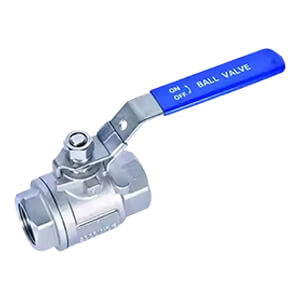What is a Ball Valve
A ball valve is a valve with a spherical ball inside, which controls the flow of liquids and gases through a pipe. The ball has a hole (port) through its center that, when aligned with the flow path, allows fluid to pass through. When rotated 90 degrees, the ball blocks the flow. This simple yet effective design makes ball valves highly reliable for on/off control and flow regulation in a variety of applications. Ball valves are available in different designs depending on how the valve body is constructed. The main types—one-piece, two-piece, and three-piece—are defined by the number of components used in their construction.
One-Piece Ball Valve
A one-piece ball valve is constructed with a single body that houses the ball and other internal components. The body is solid, with no separation between the components.
Advantages
Simplicity: One-piece ball valves have a straightforward design with fewer parts, making them easy to operate and maintain.
Compact and Lightweight: The single body construction makes these valves smaller and lighter than other types, saving space and reducing installation weight.
Cost-Effective: Due to the simple construction, one-piece valves are generally more affordable than their two-piece and three-piece counterparts.
Leak-Proof: The solid body provides excellent sealing, ensuring minimal chances of leaks.
Disadvantages
Difficult Maintenance: If a part inside the valve fails or needs replacement, the entire valve must be removed and replaced, as there is no access for servicing individual components.
Limited Size Availability: One-piece ball valves are typically available in smaller sizes, making them unsuitable for larger pipe diameters or high-flow applications.
Best Use Cases
Small-scale systems where cost-effectiveness, space-saving, and simple on/off control are priorities.
Applications with relatively low pressure and flow requirements.
Two-Piece Ball Valve
A two-piece ball valve consists of two parts: one body housing the ball and stem, and another part housing the valve ends. These parts are bolted together, allowing for easier assembly and disassembly.
Advantages
Easier Maintenance: The two-piece construction allows for easy access to internal parts, making it more convenient to service, repair, or replace components.
Stronger Design: The bolted body design provides more strength and durability compared to one-piece valves, making them suitable for medium-pressure applications.
Cost-Effective Compared to Three-Piece Valves: While still providing the option for maintenance and repair, two-piece ball valves are more affordable than three-piece models.
Disadvantages
Limited Disassembly Flexibility: While easier to maintain than one-piece valves, two-piece valves still require the entire valve to be removed from the pipeline for disassembly, which can be cumbersome in larger systems.
Size Limitations: Like one-piece valves, two-piece models are often best suited for medium- to smaller-scale applications.
Best Use Cases
Medium-scale industrial applications, including water treatment, HVAC systems, and some chemical processing.
Applications where valve maintenance is needed but where the system is not too complex.
Three-Piece Ball Valve
A three-piece ball valve consists of three parts: two end caps and a central body. This design allows easy removal and replacement of the central body without having to disassemble the entire valve, making it highly serviceable.
Advantages
Easiest to Maintain: The three-piece design allows easy access to internal components for cleaning, inspection, and replacement, making it the preferred choice in systems requiring frequent maintenance.
Versatility: The body can be removed without disturbing the pipe connections, making it an excellent option for repairs or upgrades.
Durable and High-Pressure Rated: The robust construction allows three-piece valves to handle high pressures and flow rates, making them ideal for demanding applications.
Ideal for Larger Systems: Three-piece valves can be used for larger systems where flexibility and maintenance access are crucial.
Disadvantages
Higher Initial Cost: Three-piece ball valves are more expensive due to their more complex design and the additional components.
Bulkier Design: These valves are larger and heavier, making them less ideal for applications with space constraints.
Installation Complexity: The assembly and disassembly process for three-piece valves is more involved than for one-piece and two-piece valves.
Best Use Cases
Large industrial applications, such as oil and gas pipelines, chemical processing plants, and high-pressure systems.
Systems requiring frequent maintenance or repairs, especially when easy disassembly and reassembly are necessary.

.png)
 en |
en |















